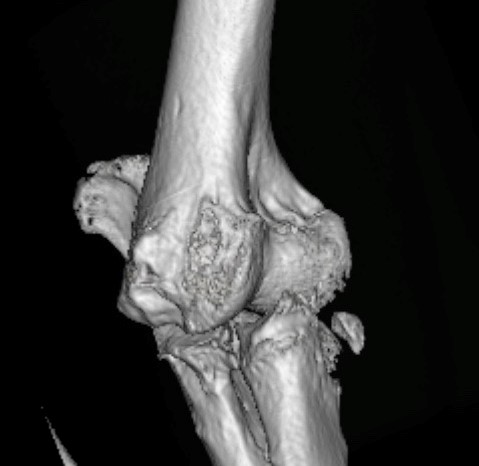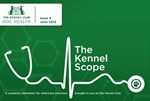World’s largest elbow disease study helps owners of large-breed dogs
Problems with the elbow joint are a common cause of lameness in dogs and consequently a huge source of worry for owners.
To assist owners to better understand how to help their dogs, the Royal Veterinary College (RVC) has just completed the largest ever study of elbow disease in dogs attending first opinion veterinary practices in the UK. The results have highlighted which breeds are most at risk in order to assist owners to be alert for the signs of this condition and to seek veterinary treatment early.

The research, led by the RVC VetCompass™ programme, reveals that elbow joint disease affects 0.6% of dogs under primary veterinary care. Over 60% of these dogs were affected in both elbows, which can make it even harder for these dogs to walk without pain. The most common presenting signs reported by owners were lameness (75.65%), difficulty exercising (19.97%) and pain (13.96%). Even more worrying was the discovery that their elbow joint disease contributed to the decision to euthanase for over 40% of affected dogs that died during the study.
These findings highlight elbow joint disease as a relatively common diagnosis with a high impact on the quality of life of affected dogs. Five breeds had especially high risk of elbow joint disease compared with crossbred dogs (in descending order): Rottweiler (x6 risk), Labrador Retriever (x6 risk), German Shepherd Dog (x4 risk), Golden Retriever (x3 risk) and English Springer Spaniel (x2 risk). Owners of these breeds are encouraged to be particularly alert for problems such as foreleg lameness and to seek advice from their vet as early as possible when early symptoms of elbow joint disease are exhibited. Given the strong breed predispositions for elbow joint disease, particularly in large breed dogs, there is a significant case for improving breeding programmes and developing improved genetic assessment tools to reduce the burden of elbow joint disease.
Other key findings by the researchers include:
- The most common specific types of elbow joint disease are arthritis (75.97%), elbow dysplasia (30.84%) and traumatic (6.66%)
- Common medications used include non-steroidal anti-inflammatory drugs (88.31%), tramadol (19.64%) and disease modifying agents (19.16%)
- Two breeds had reduced risk of elbow joint disease compared with crossbreds: Jack Russell Terrier and West Highland White Terrier
- Dogs aged 9 to 12 years had 2.56 times the risk of elbow joint disease compared to dogs under 3 years. Males had 1.47 times the risk of elbow joint disease compared with females
- Neutered animals have 1.69 times the risk of elbow joint disease compared with entire animals. Insured dogs were 2.32 times more likely to be diagnosed with elbow joint disease compared with uninsured dogs
- The risk of elbow joint disease increases substantially as adult bodyweight increases
The research was carried out by the RVC’s VetCompass programme and is the largest study on elbow disease carried out worldwide to date. The study population comprised 455,069 dogs under veterinary care at 304 clinics in the UK during 2013, with 804 elbow joint disease cases confirmed from this sample.
Dr Dan O’Neill, senior lecturer at the RVC and author of the paper said: “Vets and owners have known for a long time that elbow joint disease can severely impact welfare in dogs. This study helps owners to spot this condition earlier by highlighting the breeds and types of dogs that are typically afflicted. Owners of larger breeds, especially Rottweilers, Labrador Retrievers, German Shepherd Dogs, Golden Retrievers and English Springer Spaniels, should be especially alert for typical foreleg lameness. Owners can also check for the results of elbow disease to reduce the risks if they are considering getting a new puppy. It is wonderful to see VetCompass partnering with owners and vets to take better care of their dogs.”
Dr Richard Meeson, Head of Orthopaedics at the RVC and co-author of the paper said: “This study has provided hard evidence of what I see frequently in the clinic; high numbers of dogs severely affected by a range of problems in their elbow joints, often severe enough to need long-term medication or surgery. We are looking for new ways to help these dogs, but avoiding the problem in the first place would be best”.
Bill Lambert, Head of Health and Welfare at the Kennel Club, added: “This research, funded by the Kennel Club Charitable Trust, complements the study conducted by the Kennel Club last year and demonstrates how vital it is that we continue to work together with vets and breeders with the aim of improving dog health overall. We continue to encourage all breeders, particularly those with breeds more predisposed to elbow dysplasia, to utilise the Kennel Club/BVA Elbow Dysplasia Scheme which is proven to help reduce the risk of dysplasia in future generations. Meanwhile it is clear that owners can help too, as by keeping their dogs healthy and fit, and ensuring they don’t put on excess weight , their dogs have a better chance of avoiding this condition."
Research Reference
O'Neill DG, Brodbelt DC, Hodge R, Church DB, Meeson RL: Epidemiology and clinical management of elbow joint disease in dogs under primary veterinary care in the UK. Canine Medicine and Genetics 2020,7(1):1. The full paper is open access and is available free: doi.org/10.1186/s40575-020-0080-5
An infographic of the paper is also available: Elbow disease in dogs - A big problem for big dogs
Notes to Editors
For more information please contact:
- Jasmin De Vivo (Jasmin.DeVivo@plmr.co.uk)
- Press Line: 0800 368 9520
About the RVC
- The Royal Veterinary College (RVC) is the UK's largest and longest established independent veterinary school and is a Member Institution of the University of London. It was the first in the world to hold full accreditation from AVMA, EAEVE, RCVS and AVBC.
- The RVC is ranked as the world’s number one veterinary school in the QS World University Rankings by subject, 2019.
- The RVC offers undergraduate and postgraduate programmes in veterinary medicine, veterinary nursing and biological sciences.
- In 2017, the RVC received a Gold award from the Teaching Excellence Framework (TEF) – the highest rating a university can receive.
- A research led institution with 79% of its research rated as internationally excellent or world class in the Research Excellence Framework 2014.
- The RVC provides animal owners and the veterinary profession with access to expert veterinary care and advice through its teaching hospitals and first opinion practices in London and Hertfordshire.


